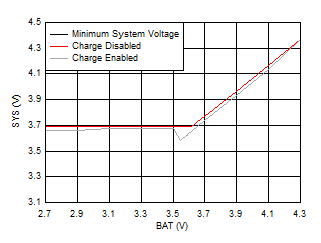ZHCSLX8B October 2020 – July 2024 BQ25618E , BQ25619E
PRODUCTION DATA
- 1
- 1 特性
- 2 应用
- 3 说明
- 4 说明(续)
- 5 器件比较表
- 6 引脚配置和功能
- 7 规格
- 8 详细说明
- 9 应用和实施
- 10电源相关建议
- 11布局
- 12器件和文档支持
- 13修订历史记录
- 14机械、封装和可订购信息
8.3.4.1 窄电压直流 (NVDC) 架构
该器件部署 NVDC 架构,BATFET 可将系统与电池分离。最小系统电压由 SYS_MIN 位设置。即使电池电量完全耗尽,也可将系统电压调节至高于最小系统电压。
当电池电压低于最小系统电压设置时,BATFET 以线性模式(LDO 模式)运行,并且系统电压通常比最小系统电压设置高 180mV。当电池电压上升到高于最小系统电压时,BATFET 将完全导通,系统和电池之间的电压差为 BATFET 的 VDS。
当电池充电被禁用并且高于最小系统电压设置,或者充电终止时,系统电压将始终调节至比电池电压高 50mV(典型值)。当系统处于最小系统电压调节状态时,状态寄存器 VSYS_STAT 位变为 1。
 图 8-1 系统电压与电池电压间的关系
图 8-1 系统电压与电池电压间的关系